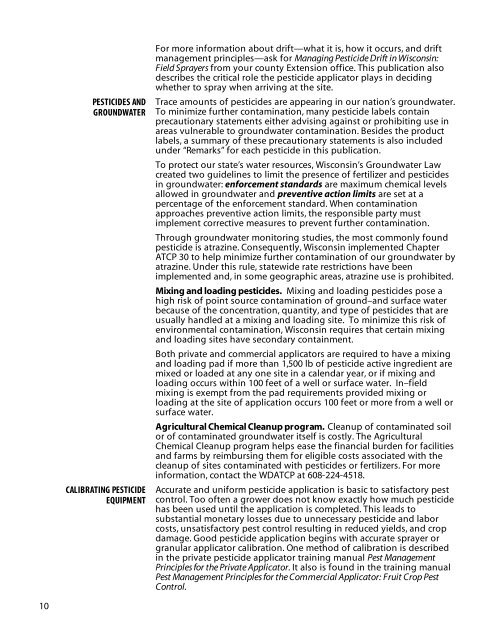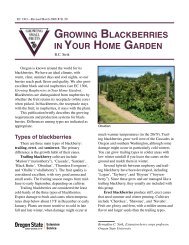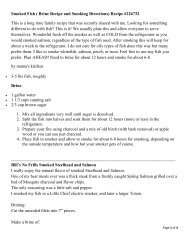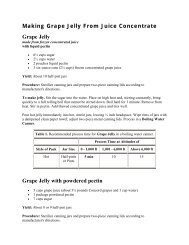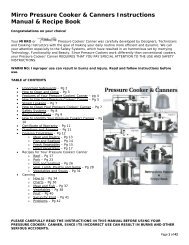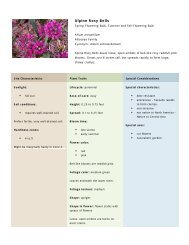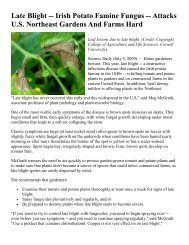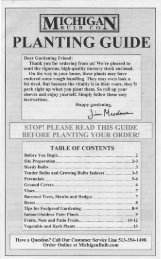Strawberry and Raspberry Pest Management in Wisconsin
Strawberry and Raspberry Pest Management in Wisconsin
Strawberry and Raspberry Pest Management in Wisconsin
You also want an ePaper? Increase the reach of your titles
YUMPU automatically turns print PDFs into web optimized ePapers that Google loves.
10<br />
PESTICIDES AND<br />
GROUNDWATER<br />
CALIBRATING PESTICIDE<br />
EQUIPMENT<br />
For more <strong>in</strong>formation about drift—what it is, how it occurs, <strong>and</strong> drift<br />
management pr<strong>in</strong>ciples—ask for Manag<strong>in</strong>g <strong>Pest</strong>icide Drift <strong>in</strong> Wiscons<strong>in</strong>:<br />
Field Sprayers from your county Extension office. This publication also<br />
describes the critical role the pesticide applicator plays <strong>in</strong> decid<strong>in</strong>g<br />
whether to spray when arriv<strong>in</strong>g at the site.<br />
Trace amounts of pesticides are appear<strong>in</strong>g <strong>in</strong> our nation’s groundwater.<br />
To m<strong>in</strong>imize further contam<strong>in</strong>ation, many pesticide labels conta<strong>in</strong><br />
precautionary statements either advis<strong>in</strong>g aga<strong>in</strong>st or prohibit<strong>in</strong>g use <strong>in</strong><br />
areas vulnerable to groundwater contam<strong>in</strong>ation. Besides the product<br />
labels, a summary of these precautionary statements is also <strong>in</strong>cluded<br />
under “Remarks” for each pesticide <strong>in</strong> this publication.<br />
To protect our state’s water resources, Wiscons<strong>in</strong>’s Groundwater Law<br />
created two guidel<strong>in</strong>es to limit the presence of fertilizer <strong>and</strong> pesticides<br />
<strong>in</strong> groundwater: enforcement st<strong>and</strong>ards are maximum chemical levels<br />
allowed <strong>in</strong> groundwater <strong>and</strong> preventive action limits are set at a<br />
percentage of the enforcement st<strong>and</strong>ard. When contam<strong>in</strong>ation<br />
approaches preventive action limits, the responsible party must<br />
implement corrective measures to prevent further contam<strong>in</strong>ation.<br />
Through groundwater monitor<strong>in</strong>g studies, the most commonly found<br />
pesticide is atraz<strong>in</strong>e. Consequently, Wiscons<strong>in</strong> implemented Chapter<br />
ATCP 30 to help m<strong>in</strong>imize further contam<strong>in</strong>ation of our groundwater by<br />
atraz<strong>in</strong>e. Under this rule, statewide rate restrictions have been<br />
implemented <strong>and</strong>, <strong>in</strong> some geographic areas, atraz<strong>in</strong>e use is prohibited.<br />
Mix<strong>in</strong>g <strong>and</strong> load<strong>in</strong>g pesticides. Mix<strong>in</strong>g <strong>and</strong> load<strong>in</strong>g pesticides pose a<br />
high risk of po<strong>in</strong>t source contam<strong>in</strong>ation of ground–<strong>and</strong> surface water<br />
because of the concentration, quantity, <strong>and</strong> type of pesticides that are<br />
usually h<strong>and</strong>led at a mix<strong>in</strong>g <strong>and</strong> load<strong>in</strong>g site. To m<strong>in</strong>imize this risk of<br />
environmental contam<strong>in</strong>ation, Wiscons<strong>in</strong> requires that certa<strong>in</strong> mix<strong>in</strong>g<br />
<strong>and</strong> load<strong>in</strong>g sites have secondary conta<strong>in</strong>ment.<br />
Both private <strong>and</strong> commercial applicators are required to have a mix<strong>in</strong>g<br />
<strong>and</strong> load<strong>in</strong>g pad if more than 1,500 lb of pesticide active <strong>in</strong>gredient are<br />
mixed or loaded at any one site <strong>in</strong> a calendar year, or if mix<strong>in</strong>g <strong>and</strong><br />
load<strong>in</strong>g occurs with<strong>in</strong> 100 feet of a well or surface water. In–field<br />
mix<strong>in</strong>g is exempt from the pad requirements provided mix<strong>in</strong>g or<br />
load<strong>in</strong>g at the site of application occurs 100 feet or more from a well or<br />
surface water.<br />
Agricultural Chemical Cleanup program. Cleanup of contam<strong>in</strong>ated soil<br />
or of contam<strong>in</strong>ated groundwater itself is costly. The Agricultural<br />
Chemical Cleanup program helps ease the f<strong>in</strong>ancial burden for facilities<br />
<strong>and</strong> farms by reimburs<strong>in</strong>g them for eligible costs associated with the<br />
cleanup of sites contam<strong>in</strong>ated with pesticides or fertilizers. For more<br />
<strong>in</strong>formation, contact the WDATCP at 608-224-4518.<br />
Accurate <strong>and</strong> uniform pesticide application is basic to satisfactory pest<br />
control. Too often a grower does not know exactly how much pesticide<br />
has been used until the application is completed. This leads to<br />
substantial monetary losses due to unnecessary pesticide <strong>and</strong> labor<br />
costs, unsatisfactory pest control result<strong>in</strong>g <strong>in</strong> reduced yields, <strong>and</strong> crop<br />
damage. Good pesticide application beg<strong>in</strong>s with accurate sprayer or<br />
granular applicator calibration. One method of calibration is described<br />
<strong>in</strong> the private pesticide applicator tra<strong>in</strong><strong>in</strong>g manual <strong>Pest</strong> <strong>Management</strong><br />
Pr<strong>in</strong>ciples for the Private Applicator. It also is found <strong>in</strong> the tra<strong>in</strong><strong>in</strong>g manual<br />
<strong>Pest</strong> <strong>Management</strong> Pr<strong>in</strong>ciples for the Commercial Applicator: Fruit Crop <strong>Pest</strong><br />
Control.


